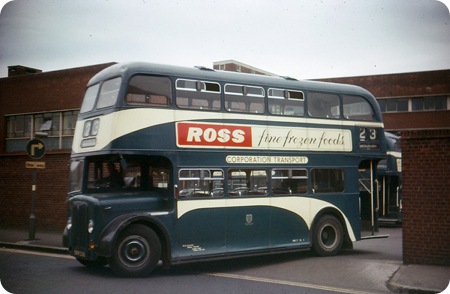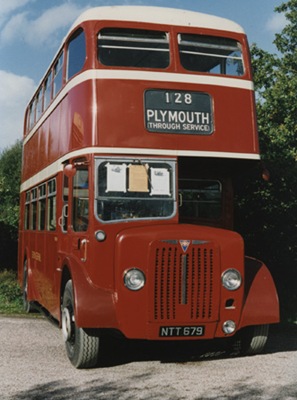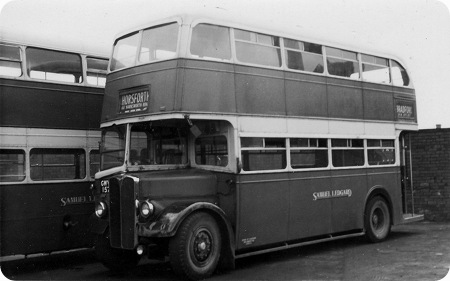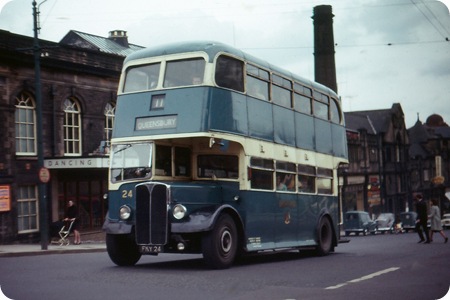Hull Corporation – AEC Regent III – OKH 336 – 336
Kingston upon Hull Corporation Transport
1953
AEC Regent III
Weymann "Auroa" H32/26R
Regent III I hear you shout, yes I thought it was a Daimler as well, until Paul Morfitt a K.H.C.T. expert pointed it out to me. K.H.C.T. bought 6 of these Regent IIIs with the Birmingham style tin front, they were apparently the last front engine/open platform buses bought brand new by them. Fleet number 337 is now fully preserved and should be out on the rally circuit next summer (2010) so keep your eye out for it. There is also a restored Bradford City Transport Regent III with a similar tin front it can be seen here.
04/04/13 – 06:28
The Weymann Aurora body is something of an enigma. The first one – also co-incidentally on an AEC Regent III with tin front – was built for Devon General and exhibited on the MCW stand at Earls Court in 1952 alongside the prototype Orion. An MCW sales brochure was produced, which was still being distributed two years later, but no more bodies of that type were ever built. In the meantime Weymann had been building this much more elegant design, which most people agree bears no resemblance to the prototype described in the brochure, and which could instead be traced back much more clearly to earlier Weymann bodies. It is almost as though Weymann simply thumbed its nose at the MCW design team and just carried on with their own design evolution as if nothing had happened.
To confuse matters still further, a brief article in a recent edition of Classic Bus magazine, describing the prototype (which is now preserved) as unique, it was answered by not one but two letters referring to production Auroras as "virtually identical" to the prototype – one of them referring to these Hull vehicles and the other I think to some Bristols for Maidstone and District. It seems that resemblance, like beauty, is in the eye of the beholder!
Peter Williamson
04/04/13 – 08:29
The Aurora is certainly an enigma – and a trap for those who only know half the story. I too have been puzzled by the lack of similarity between to prototype and production versions but the Weymann Story (in two volumes Senior/Venture) is very clear. The Aurora name was used for these modernised versions of the classic Weymann design (produced from 1953 to 1959). The MCCW Orion design was produced at Addlestone from about 1953 (the first being re-bodies of war time Guys for Maidstone & District). Interestingly, Addlestone were also building Aurora bodies on war time Bristols for M & D. What most people didn’t realise – me included – is that the Aurora name was then resurrected as the official and proper name for the forward entrance version on the Orion.
David Oldfield
04/04/13 – 11:03
Just remembered the Bournemouth trolleys which had the Aurora as late as 1962.
David Oldfield
04/04/13 – 11:04
Here is a photo of the preserved one-off 1952 Aurora, Devon General NTT 679, taken at the Devon General Running Day at Newton Abbott in 1993.
John Stringer
04/04/13 – 15:49
The main difference between the prototype Aurora and the production model seems to be the move from pan window fixing to rubber mounting. 
Here is an example of the production version as supplied to Birkenhead Corporation in 1954. Apart from being on an exposed radiator chassis, it differs from the Hull version in having a 5-bay body. The traditional Weymann drooping saloon window is much in evidence. Birkenhead dabbled with Weymann as a body supplier. The batch of 10 Auroras was not the whole of the CBG intake, the remaining 5 of the batch having locally-built Ashcroft bodies. The 1955 intake of 17 vehicles (10 PD2 and 7 Arab IV) saw half the PD2s bodied with the Orion style, and finally in 1964 came the one-off batch of 10 Fleetlines, again with Orion style, one of which appears on the left of the picture. (Originally delivered with the cream relief as window surrounds only, the appearance of the Fleetlines was much improved with the application of the standard livery on repaint, as seen here.)
Alan Murray-Rust
05/04/13 – 05:51
To me there are more differences than similarities. On the prototype, the dimensions of the windows – deep lower, shallow upper – are more like a production Orion than any other Aurora (and the deep lower deck windows were made much of in the sales brochure). On the production version, as Alan says, the traditional Weymann drooping bulkhead window is much in evidence, whereas on the prototype the top rail is straight and only the bottom curved, again just like most highbridge Weymann Orions. In fact the only similarities I can find (using other images) are in the front and rear domes and the rear emergency window.
Peter Williamson
23/04/13 – 07:50
My favourite bus, thin steering wheel and a smooth seat which you could slide off on exit from a roundabout and if it was a hot day and your cab door was open it could be interesting. A lot of drivers didn’t like them because you couldn’t see the pavement from the cab. I thought they were great, the exhaust would roar when you put your foot down.
box501
03/06/14 – 12:52
The Daimler and Guy Utilities of Maidstone and District were rebodied with a later form of five bay Weymann body derived from the pre and early post war design but with deeper windows upstairs. Only some Utility Bristol K6As had four bay ‘Aurora’ or five bay ‘Orion’ bodies. The only Orion bodied Guys which Maidstone and District had, were the Guy Arab IVs acquired or ordered by Chatham and District which were based on new post war chasses.
Gordon Mackley
Quick links to the - Comments Page - Contact Page - Home Page




